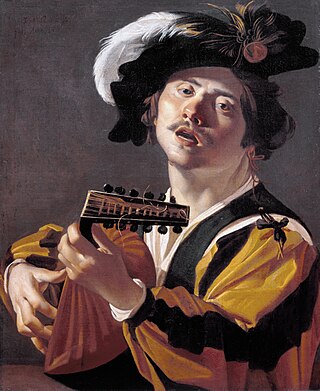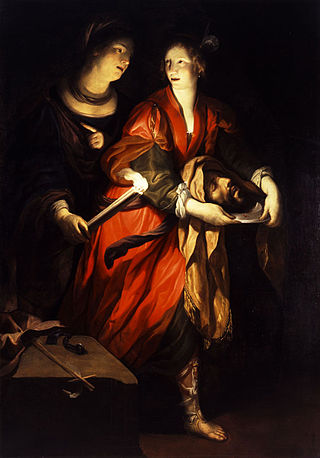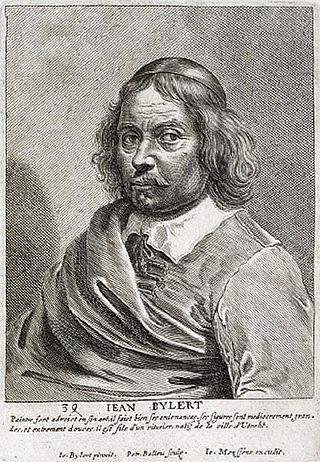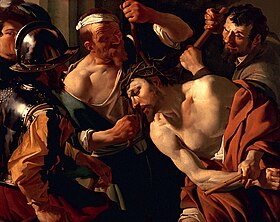
Chiaroscuro, in art, is the use of strong contrasts between light and dark, usually bold contrasts affecting a whole composition. It is also a technical term used by artists and art historians for the use of contrasts of light to achieve a sense of volume in modelling three-dimensional objects and figures. Similar effects in cinema, and black and white and low-key photography, are also called chiaroscuro.

Dirck Jaspersz. van Baburen was a Dutch painter and one of the Utrecht Caravaggisti.

The Caravaggisti were stylistic followers of the late 16th-century Italian Baroque painter Caravaggio. His influence on the new Baroque style that eventually emerged from Mannerism was profound. Caravaggio never established a workshop as most other painters did, and thus had no school to spread his techniques. Nor did he ever set out his underlying philosophical approach to art, the psychological realism which can only be deduced from his surviving work. But it can be seen directly or indirectly in the work of Rubens, Jusepe de Ribera, Bernini, and Rembrandt. Famous while he lived, Caravaggio himself was forgotten almost immediately after his death. Many of his paintings were re-ascribed to his followers, such as The Taking of Christ, which was attributed to the Dutch painter Gerrit van Honthorst until 1990.

Abraham Bloemaert was a Dutch painter and printmaker who used etching and engraving. He initially worked in the style of the "Haarlem Mannerists", but by the beginning of the 17th-century altered his style in line with the new Baroque style that was then developing. He mostly painted history subjects and some landscapes. He was an important teacher, who trained most of the Utrecht Caravaggisti.

Gerard van Honthorst was a Dutch Golden Age painter who became known for his depiction of artificially lit scenes, eventually receiving the nickname Gherardo delle Notti. Early in his career he visited Rome, where he had great success painting in a style influenced by Caravaggio. Following his return to the Netherlands he became a leading portrait painter. Van Honthorst's contemporaries included Utrecht painters Hendrick Ter Brugghen and Dirck van Baburen.

Abraham Janssens I, Abraham Janssen I or Abraham Janssens van Nuyssen (1575–1632) was a Flemish painter, who is known principally for his large religious and mythological works, which show the influence of Caravaggio. He was the leading history painter in Flanders prior to the return of Rubens from Italy.

Hendrick Jansz ter Brugghen was a Dutch painter of genre scenes and religious subjects. He was one of the Dutch followers of Caravaggio – the so-called Utrecht Caravaggisti. Along with Gerrit van Hondhorst and Dirck van Baburen, Ter Brugghen was one of the most important Dutch painters to have been influenced by Caravaggio.

Gioacchino Assereto was an Italian painter of the early Baroque period and one of the most prominent history painters active in Genoa in the first half of the 17th century.

Nicolas Régnier (1591–1667), known in Italy as Niccolò Renieri, was a painter, art dealer and art collector from the County of Hainaut, a French-speaking part of the Spanish Netherlands. He is often referred to as a Flemish artist because this term was often used to designate people from the Spanish Netherlands. After training in Antwerp, he was active in Italy where he was part of the international Caravaggesque movement. His subjects include genre scenes with card players, fortune tellers, soldiers and concerts, religious scenes, saints, mythological and allegorical scenes, and portraits. He also painted a few scenes with carnivals.

Angelo Caroselli or Carosèlli was an Italian painter of the Baroque period, active mainly in his native Rome. He created religious works, allegories, portraits as well as genre scenes in the vein of the Caravaggisti. He also returned regularly to scenes of witchcraft and sorcery. His style is eclectic style and shows influences principally from Caravaggio and the painters of 'low-life' scenes active in Rome called the Bamboccianti. His work is characterised by its search for originality. This is demonstrated in the potent naturalism and chiaroscuro that characterise his compositions and his preference for depicting colorful characters of contemporary Rome and scenes of witchcraft and musicians. The work of Caroselli was influential on other Caravaggisti such as the Lucchese painter Pietro Paolini and the Dutch painter Dirck van Baburen.

Francesco Rustici, called Il Rustichino was an Italian painter active in Siena. He worked on commissions for the local churches as well as from the Grand-Dukes of Tuscany. In his work he shows a preference for nocturnal effects which reveals the influence of Caravaggio and his followers, the so-called Caravaggisti.

Theodoor Rombouts was a Flemish painter who is mainly known for his Caravaggesque genre scenes depicting lively dramatic gatherings as well as religiously-themed works. He is considered to be the primary and most original representative of Flemish Caravaggism. These Caravaggisti were part of an international movement of European artists who interpreted the work of Caravaggio and the followers of Caravaggio in a personal manner.

The Centraal Museum is the main museum in Utrecht, Netherlands, founded in 1838. The museum has a wide-ranging collection, mainly of works produced locally. The collection of the paintings by the Northern Mannerist Joachim Wtewael is by a long way the largest anywhere in the world. Other highlights are many significant paintings by the Utrecht Caravaggisti, such as Gerard van Honthorst and Hendrick ter Brugghen. Both of them travelled to Rome in the early 17th century to study the works of the Italian master Caravaggio. In the previous generation, as well as Wtewael, Abraham Bloemaert and the portraitist Paulus Moreelse were the most significant Utrecht painters, with Jan van Scorel still earlier.

Gerard Seghers was a Flemish painter, art collector, and art dealer. After a period of study and residence in Italy, he returned to Flanders where he became one of the leading representatives of the Flemish Caravaggisti movement. In his later career he abandoned the Caravaggist style and genre motifs to become an important painter of large altarpieces for local churches.

Adam de Coster was a Flemish painter. He was a prominent member of the Antwerp Caravaggisti. These Caravaggisti were part of an international movement of European artists who interpreted the work of Caravaggio and the followers of Caravaggio in a personal manner. He is mainly known for his genre scenes with strong chiaroscuro effects. He was called a Pictor Noctium because of his preference for tenebrist scenes.

Matthias Stom or Matthias Stomer was a Dutch, or possibly Flemish, painter who is only known for the works he produced during his residence in Italy. He was influenced by the work of non-Italian followers of Caravaggio in Italy, in particular his Dutch followers often referred to as the Utrecht Caravaggists, as well as by Jusepe de Ribera and Peter Paul Rubens. He did not share the other Northern Caravaggisti's preference for humorous, and sometimes scabrous, genre scenes and elaborate decorative allegories but favored stories from the bible instead. He worked in various locations in Italy where he enjoyed the patronage of religious institutions as well as prominent members of the nobility.

Jan Hermansz van Bijlert was a Dutch Golden Age painter from Utrecht, one of the Utrecht Caravaggisti whose style was influenced by Caravaggio. He spent some four years in Italy and was one of the founders of the Bentvueghels circle of northern painters in Rome.

Jan Janssens was a Flemish Baroque painter and draftsman who is considered to be the most important of the so-called Ghent Caravaggisti. These Caravaggisti were part of an international movement of European artists who interpreted the work of Caravaggio and the followers of Caravaggio in a personal manner. Janssens altarpieces and other compositions offering very realistic representations of religious motifs adorn many churches in and around Ghent. He also worked on commissions for international patrons.

Jacques de l'Ange or the Monogrammist JAD was a Flemish painter and draughtsman known for his genre scenes and history paintings executed in a Caravaggesque style. The artist was only rediscovered in the mid-1990s as his work was previously attributed to other Northern Caravaggists and in particular the Utrecht School Caravaggists or Flemish Carravagists.

Saint Sebastian Tended by Irene is an oil-on-canvas painting by Hendrick ter Brugghen dated to 1625. Now in the Allen Memorial Art Museum of Oberlin, Ohio, the piece depicts the Roman Catholic subject of Saint Sebastian Tended by Saint Irene, after Irene of Rome and her maid rescued him following his attempted martyrdom by the Roman authorities. An exemplary piece of the Italianate Baroque tendency in Dutch Golden Age painting, the painting employs dramatic uses of light and skillful chiaroscuro to depict its religious subject, evidence of influence from Caravaggio and Ter Brugghen's fellow Utrecht Caravaggisti.






















